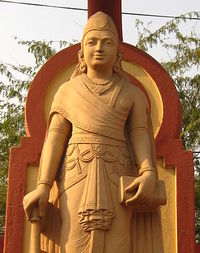Chandragupta Maurya Monarch
Chandragupta Maurya The Great (340 BC – 298 BC) was the founder of the Maurya Empire and the first emperor to unify most of Greater India into one state. He ruled from 322 BC until his voluntary retirement and abdication in favour of his son Bindusara in 298 BC.Chandragupta Maurya was a pivotal figure in the history of India. Prior to his consolidation of power, most of Indian Subcontinent was ruled by small states, while the Nanda Empire dominated the Indus-Gangetic Plain. Chandragupta succeeded in conquering and subjugating almost all of the Indian subcontinent by the end of his reign, except the Tamil regions (Chera, Chola and Pandya) and Kalinga. His empire extended from Bengal in the east, to Afghanistan and Balochistan in the west, to the Himalayas and Kashmir in the north, and to the Deccan Plateau in the south. It was the largest empire yet seen in Indian history.After unifying much of India, Chandragupta and his chief advisor Chanakya passed a series of major economic and political reforms. He established a strong central administration patterned after Chanakya’s text on politics, the Arthashastra (English: "Economics and political science"). Maurya India was characterised by an efficient and highly organised bureaucratic structure with a large civil service. Due to its unified structure, the empire developed a strong economy, with internal and external trade thriving and agriculture flourishing. In both art and architecture, the Maurya Empire made important contributions, deriving some of its inspiration from the culture of the Achaemenid Empire and the Hellenistic world. Chandragupta's reign was a time of great social and religious reform in India. Buddhism and Jainism became increasingly prominent.In foreign Greek and Latin accounts, Chandragupta is known as Sandrokottos and Androcottus. He became well known in the Hellenistic world for conquering Alexander the Great's easternmost satrapies, and for defeating the most powerful of Alexander's successors, Seleucus I Nicator, in battle. Chandragupta subsequently married Seleucus's daughter to formalize an alliance and established a policy of friendship with the Hellenistic kingdoms, which stimulated India's trade and contact with the western world. The Greek diplomat Megasthenes, who visited the Maurya capital Pataliputra, is an important source of Maurya history.Chandragupta became Jain by faith after renouncing the throne. In the last years of his reign he took Jaineshwari Diksha from Shrutakevali Bhadrabahu to be a Muni. So he abdicated his throne and with the sangha he had gone to spend his last days at Shravanabelagola, a famous religious site in south India, where he fasted to death. Along with his grandson, Ashoka, Chandragupta Maurya is one of the most celebrated rulers in the history of India and is also known as Samrat Chakravartin. He has played a crucial role in shaping the national identity of modern India, and has been lionised as a model ruler and as a national hero.
Search
Chandragupta Maurya on Wikipedia
External resources
- http://46.1911encyclopedia.org/C/CH/CHANDRAGUPTA_MAURYA.htm
- http://digicoll.library.wisc.edu/cgi-bin/Literature/Literature-idx?type=turn&entity=Literature000701860036&isize=M&pview=hide
- http://penelope.uchicago.edu/Thayer/E/Roman/Texts/Plutarch/Lives/Alexander*/9.html#62
- http://penelope.uchicago.edu/Thayer/E/Roman/Texts/Plutarch/Lives/Alexander*/9.html#62.9
- http://penelope.uchicago.edu/Thayer/E/Roman/Texts/Strabo/15A3*.html#1.53
- http://rajyasabha.nic.in/rsnew/picture_gallery/p1.asp
- http://www.forumromanum.org/literature/justin/english/trans15.html
- http://www.forumromanum.org/literature/justin/trad15.html
- http://www.livius.org/ap-ark/appian/appian_syriaca_11.html
- http://www.mssu.edu/projectsouthasia/history/primarydocs/Foreign_Views/GreekRoman/Megasthenes-Indika.htm
